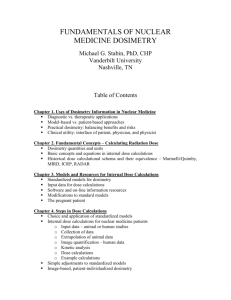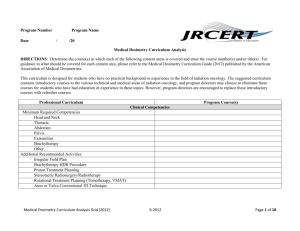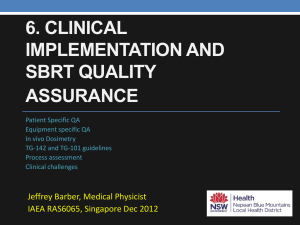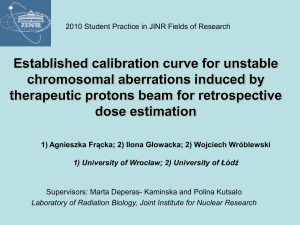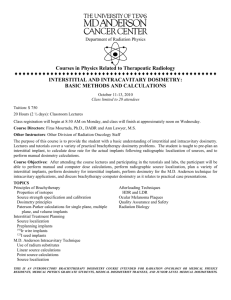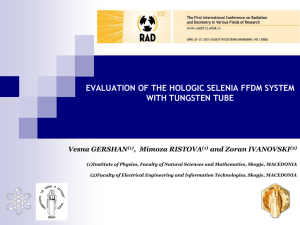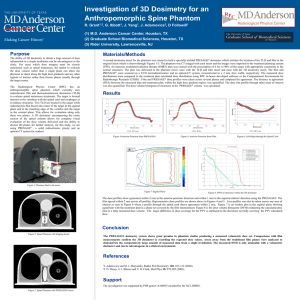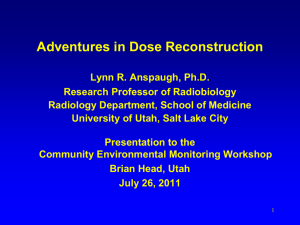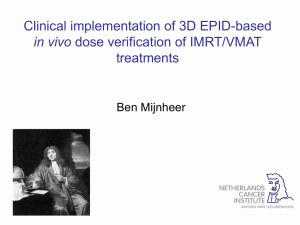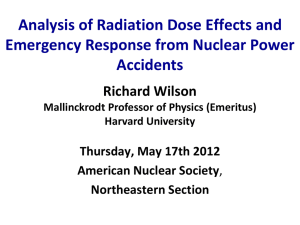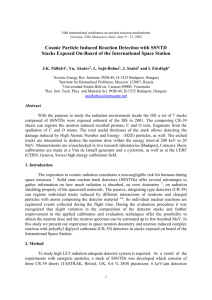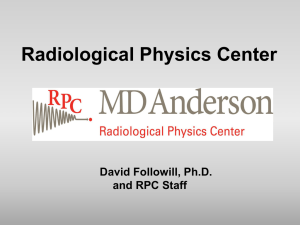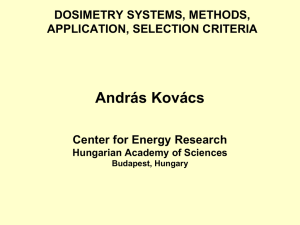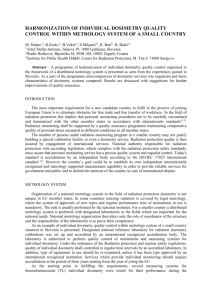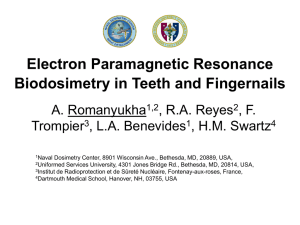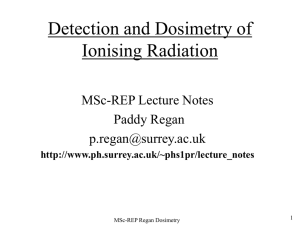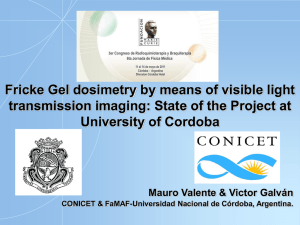What is small field?
advertisement
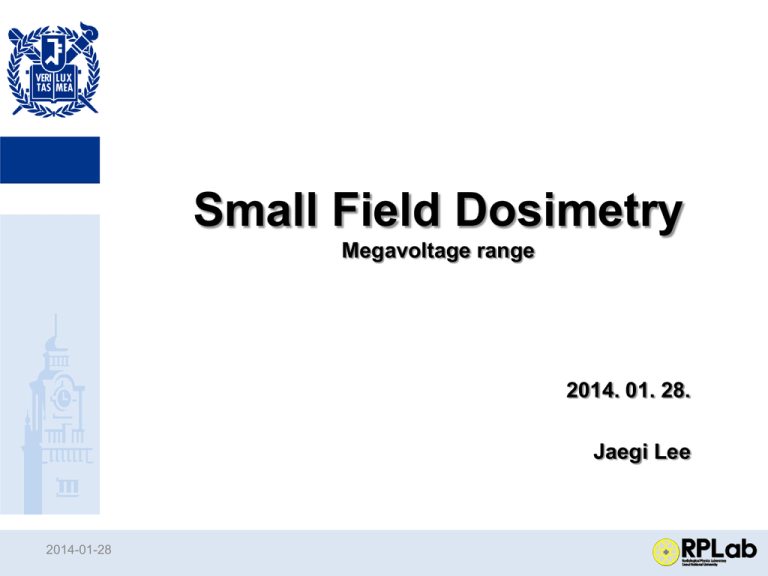
Small Field Dosimetry Megavoltage range 2014. 01. 28. Jaegi Lee 2014-01-28 Introduction • Advanced & specialized radiation treatments – Beamlet-based intensity modulated radiation therapy (IMRT) – Tomotherapy – Stereotactic radiosurgery (SRS) – Gamma Knife – CyberKnife • UK IPEM (Institute of Physics and Engineering in Medicine) Report 103 • AAPM TG-155 (unpublished) 2014-01-28 What is small field? • No clear consensus definition of small field • Commonly, – 1) a field size of less than 3 x 3 cm2 – 2) a field with a size smaller than the lateral range of charged particles • More scientific approach is needed to set the criteria which define a small field condition based on the beam energy and the density of the medium 2014-01-28 3 equilibrium factors • 1) Size of viewable parts of the beam source as projected from the detector location through the beam aperture – Underdose when only a part of the source can be viewed • 2) Size of detector – Volume averaging effects • 3) Electron range in the irradiated medium – The lateral range of the electrons is the critical parameter to the CPE 2014-01-28 Partial blocking of the beam source Underdose! 2014-01-28 http://medicalphysicsweb.org/cws/article/opinion/45334 Why is small field dosimetry important? • 30% variation at 0.5x0.5 cm2 field Ion chambers are too large for accurate measurements without the use of correction The 2 mm plane-parallel chamber and other small volume detectors. Measurements are normalized to the 10x10 cm2 reference field. 2014-01-28 McNiven et al., Medical Physics, Vol. 33, No. 11, November 2006 Why is small field dosimetry important? • Many parameters for small field dosimetry – Focal spot size and shape, collimator design and alignment • It is not possible to use published data for each radiotherapy unit – Measurement condition is different • Radiotherapy treatment planning must be based on data measured locally – Accurate measurement and modeling of the individual unit is essential 2014-01-28 Issues and problems 2014-01-28 The problem of field size definition Das, Ding, and Ahnesjö: Small fields: Nonequilibrium radiation dosimetry, Med. Phys. 35 (1), January 2008 2014-01-28 The effect of source size • MLC field profile with different x-jaw size Das, Ding, and Ahnesjö: Small fields: Nonequilibrium radiation dosimetry, Med. Phys. 35 (1), January 2008 2014-01-28 Effective SSD change in electron beam P M Ostwald and T Kron, Variation of ESSD with depth, Phys. Med. Biol. 41 (1996) 2067–2078 2014-01-28 Low-density inhomogeneity • Lung • Small fields are subject to significant perturbations. – Energy & density dependency • Loss of electronic equilibrium within and adjacent to low density materials can result in a dose reduction along the central axis and near the beam edge for megavoltage photon beams • Simple one-dimensional density scaling fail to provide accurate dose distributions. – Advanced treatment planning algorithms provide more accurate dose calculations in treatment planning. P. J. WHITE et al., Comparison of dose homogeneity effects, IJROBP, Vol 34, Number 5, 1996 2014-01-28 Output factor measurement/calculation Calc./measured ratio in small MLC with a constant jaw setting of 12 × 12 cm2. (a) Ratios for three different MLC transmission factors of 1%, 1.4%, and 1.8% (Spot size 1 mm; DLG 1.4 mm) (b) Ratios for three different dosimetric leaf gap settings of 1, 1.4, and 2 mm (Spot size 1 mm; Transmission 1.4%) (c) Ratios for three different focal spot sizes of 0, 1, and 2 mm (Transmission 1.4%; DLG 1.4 mm). 2014-01-28 Kron et al.: MLC defined small fields, Medical Physics, Vol. 39, No. 12, December 2012 Absolute dosimetry • No reference condition for some treatment modalities used in SRS treatments (Gamma Knife, CyberKnife, and tomotherapy) • No simple methods to provide absolute or reference dosimetry – Indirectly performed by transferring, extrapolating, or intercomparing methods (film, TLD, or small volume ion chamber) • RPC has undertaken intercomparing dose measurements – Significant deviations in dosimetry 2014-01-28 Overview of the dosimetry of small static fields Alfonso et al.: Reference dosimetry of small and nonstandard fields, Medical Physics, Vol. 35, No. 11, November 2008 2014-01-28 Radiation detectors 2014-01-28 Ion chambers • Usually, volume of ion chamber is larger than small fields • Asymmetry in active volume & large internal electrode Standard Imaging A1, 0.057 cc 2014-01-28 A L McNiven et al., Phys. Med. Biol. 53 (2008) 5029–5043 Semiconductors • Not tissue equivalent for low-energy photons • Part of signal is due to secondary electrons generated in the encapsulation of the detector • Dose rate dependency • Angular dependency 2014-01-28 Diamond detector • Used naturally grown diamond – Expensive • Significant variation because of size and shape • Dose rate dependency – Several percent – Negligible for output factor measurement – In depth dose measurement, overestimated by 1% • Small angular dependency 2014-01-28 Radiochromic film • QA for Stereotactic treatment using EBT2 • High spatial resolution, but scanning process limits the resolution by 0.1 mm 2014-01-28 T. Kron et al., Radiation Measurements 46 (2011) 1920-1923 Detector arrays • SunNuclear IC PROFILER • IBA MatriXX • PTW OCTAVIUS Detector 1000 srs – Very small detector size (2.3 mm x 2.3 mm x 0.5 mm) with high spatial resolution (2.5 mm) • Dose magnifying glass – 0.2 mm spatial resolution 2014-01-28 Wong et al.: Silicon strip detector for IMRT dosimetry, Medical Physics 37, 427 (2010) 3-D detectors • Sun Nuclear Arc Check – Pseudo-3-D geometry • PRESAGE – MRI & optical CT • DEFGELs – Deformable gels 2014-01-28 Yeo et al.: DEFGEL: 3D deformable dosimetry, Medical Physics 39, 2203 (2012); Advantages & disadvantages of different detector types for small field dosimetry Detector Key Feature Ionization Chamber Accuracy Diodes Small MOSFETs Very small Scintillators Small TLD/OSL Stand alone Diamonds Small Advantages Can be converted to absolute dose Robust, real-time read-out Can be combined into detector arrays Tissue equivalent Many forms available, very high sensitivity Tissue equivalent Radiochromic Determines 2-D Tissue equivalent; film dose distribution self-developing 3-D dosimeters Determines 3-D Tissue equivalent / gels dose distribution 2014-01-28 Disadvantages Relatively insensitive and large Not tissue equivalent; dose rate de pendence Not very sensitive and reproducibil ity less than other detectors Cherenkov radiation Light sensitivity Expensive, dose rate dependence, may require pre-irradiation Expensive, not very sensitive Complex evaluation, no 'standard' commercial gel available Outlook and conclusion • Small fields are increasingly employed in modern radiotherapy. – High doses to small volume – Subdivision of larger radiation fields into smaller field segments (IMRT & VMAT) – Non-uniform dose distribution (SIB technique) • Accurate dosimetry becomes more important to ensure the absolute dose • Small field dosimetry is critical for the accurate characterization of field edges and regions of steep dose gradients 2014-01-28 Discussion & Question 2014-01-28 Thank you for your attention 2014-01-28
